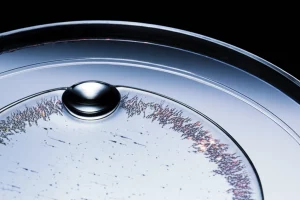Braces vs. the Pool: How Chlorine pH Affects Your Smile’s Grip
Hey there! So, I was diving into some research lately, and something really caught my eye, especially for anyone who loves hitting the pool or has kids in competitive swimming – and happens to have braces. We all know swimming is fantastic exercise, right? Great for the whole body. But sometimes, even the healthiest habits can have unexpected side effects, and turns out, chlorinated pool water might be picking a fight with your orthodontic treatment.
I stumbled upon this cool study that looked into exactly that: how the pH level of chlorinated water affects how well those metal orthodontic brackets stay glued to your teeth. You know, the little metal squares that hold your wires? Their grip is super important for moving your teeth into place.
Why Pool Water Might Be a Problem
Okay, so swimming pools use chlorine to keep things clean and kill off nasty bugs. That’s a good thing! But when chlorine mixes with water, it can create acids. Pool operators usually add stuff like soda ash to keep the water’s pH balanced, ideally between 7.2 and 7.8, which is pretty neutral, like your mouth should be.
The catch? Sometimes, pools aren’t monitored perfectly, and the pH can drop. Way down. We’re talking potentially as low as pH 3! To give you some perspective, that’s getting close to the acidity of soda or even vinegar. Yikes!
Studies have already shown that swimmers, especially competitive ones who spend a lot of time in the water, can experience dental erosion. That’s when the acid literally starts dissolving the enamel, the hard outer layer of your teeth. And if your enamel is getting weaker, what do you think that does to the *glue* holding your braces on?
What This Study Did
So, these researchers wanted to find out if exposing teeth to chlorinated water, especially the acidic kind, would weaken the bond strength of metal brackets. They did what’s called an *in vitro* study, which means they did it in a lab, not in real people’s mouths (though it’s designed to mimic real-life conditions as much as possible).
They took 126 extracted human premolar teeth (those are the ones between your pointy canines and your molars at the back). They split them into three groups:
- Group 1: Soaked in chlorinated water with a pH of 7.4 (like a well-maintained pool).
- Group 2: Soaked in chlorinated water with a pH of 3 (like a poorly maintained, acidic pool).
- Group 3: Soaked in artificial saliva with a neutral pH of 7 (this was the control group, representing a normal mouth environment).
They soaked the teeth for 12 days, which they figured would simulate about a year of regular swimming training. Pretty clever way to speed things up, right?
After the soaking period, they bonded metal brackets onto all the teeth using a standard orthodontic process. To make the lab conditions even more realistic, they put the samples through something called thermocycling. Imagine dunking the teeth in hot water (55°C) and then cold water (5°C) over and over again – 10,000 times! This mimics the temperature changes your teeth experience daily from eating and drinking, which puts stress on the bracket bond over time.
Then came the crucial part: testing the bond strength. They used a special machine to basically push the brackets off the teeth and measure how much force it took. This gives you the Shear Bond Strength (SBS), usually measured in megapascals (MPa). For brackets to work properly, you generally need a bond strength of at least 6-8 MPa.
They also looked at something called the Adhesive Remnant Index (ARI). This is a score from 0 to 3 that tells you how much of the bonding glue is left on the tooth after the bracket comes off. It helps figure out *where* the bond failed – was it between the glue and the tooth, or between the glue and the bracket?
They tested subgroups from each main group at different time points: right after bonding, after 6 days of simulated soaking (like 6 months of swimming), and after the full 12 days (like a year).

What They Found Out (The Big Reveal!)
Okay, so here’s the scoop. The results were pretty clear:
* The control group (soaked in artificial saliva) consistently had the highest bond strength across all time points. Their SBS stayed nice and strong, averaging around 9 MPa. This makes sense – artificial saliva is designed to be kind to teeth and doesn’t mess with the enamel or the glue.
* The group soaked in chlorinated water at a normal pH (7.4) had lower bond strength than the control group. And, interestingly, their bond strength decreased over the 12 days of soaking, dropping from about 7.3 MPa initially to around 5.6 MPa after 12 days. While 7.3 MPa is generally okay for clinical use, dropping to 5.6 MPa is below that recommended minimum.
* Now, for the group soaked in the *acidic* chlorinated water (pH 3) – this is where things got significantly weaker. Their initial bond strength was lower than the neutral chlorine group (around 6.1 MPa), and it also dropped over time, hitting a low of about 4.5 MPa after 12 days. That’s well below the minimum needed for effective tooth movement.
The difference in bond strength between the acidic chlorine group (pH 3) and both the neutral chlorine group (pH 7.4) and the control group (pH 7) was statistically significant. This means it wasn’t just random chance; the acidic water *really* did weaken the bond.
What about the ARI scores, the glue remnants? Interestingly, the study found no significant difference in the ARI scores between any of the groups or time points. Most failures were either between the glue and the tooth (adhesive failure) or within the glue itself (cohesive failure). This suggests that while the *strength* of the bond was affected by the acidic water, the *way* it failed wasn’t dramatically different. The acidic environment seemed to weaken both the enamel surface and potentially the adhesive material itself.
Why This Matters for Swimmers with Braces
So, what’s the takeaway from all this? If you or your kids are serious swimmers and wear metal braces, the pH of the pool water really *does* matter. Prolonged exposure to acidic chlorinated water can weaken the bond holding your brackets on. This could potentially lead to more frequent bracket breakages or detachments, which means more trips to the orthodontist to get them re-bonded, potentially extending treatment time and adding hassle.
The study’s findings strongly suggest that the acidity causes enamel erosion, making the tooth surface a less-than-ideal base for the adhesive. Even the neutral chlorinated water showed a decrease in bond strength over time compared to artificial saliva, hinting that maybe the chlorine itself, or prolonged water exposure, might have some effect on the adhesive too, though the acidic pH was the bigger culprit.

The good news is that this study highlights the importance of pool maintenance. If pool operators keep the pH in the recommended range (7.2-7.8), the risk is significantly reduced compared to highly acidic conditions.
Limitations and What’s Next
Like any study, this one had limitations. It was done in a lab, not in a real mouth, which is a complex environment with saliva, food, and bacteria. They only used one type of tooth (premolars) and one type of metal bracket and adhesive. Also, keeping the pH perfectly stable in the lab solutions for 12 days, despite daily changes, can be tricky.
The researchers themselves suggested some next steps for future studies:
- Using a scanning electron microscope to get a super close look at how the chlorinated water affects the enamel surface.
- Investigating how chlorinated water might affect the physical and mechanical properties of clear aligners (like Invisalign), which are becoming super popular.
Wrapping It Up
So, there you have it. This study gives us some pretty solid evidence that acidic chlorinated pool water can weaken the bond strength of metal orthodontic brackets. For swimmers with braces, this underscores the importance of swimming in well-maintained pools where the pH is properly controlled. It’s another little piece of the puzzle in understanding how our environment interacts with our dental health, especially when we’re undergoing orthodontic treatment. Keep swimming, but maybe give a little thought to the water quality!
Source: Springer







